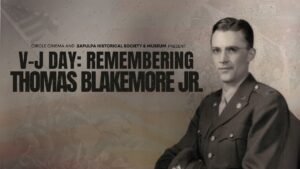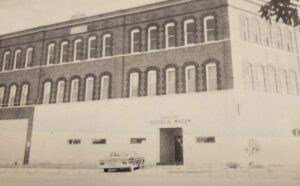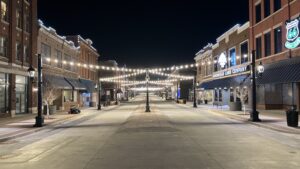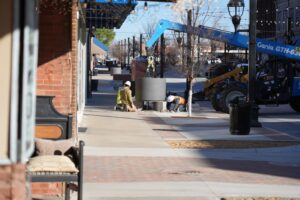Rachel Whitney, Curator,
Sapulpa Historical Museum
An exposé story for a newspaper reveals the truth that may be hidden or unaware to the audience. In March 1912, the Sapulpa newspapers had a couple of exposé stories, but they both may not have been telling the whole truth. One newspaper told one story, the other newspaper said that is not how it happened; and more than one exposé would be revealed.
This week in Sapulpa history, each bounced off back and forth about the events of that week in 1912.
Sapulpa Evening Light, March 22, 1912: “Is Sapulpa Water Works Plant to Be Sold? Investigations show that such a deal is on foot among certain syndicate interests. According to a telegraph from St. Louis-is this the exposure of the greatest steal ever perpetrated in Sapulpa? There is a rumor afloat which is apparently being kept on the quiet, but it is rumored that a deal is on to sell Sapulpa’s water plant and put its control in the hands of a monopoly.”

The Sapulpa Evening Light ran a big article about the possible sale of the water plant. It stated that a rumor was being kept quiet that the water plant may be sold to a group in St. Louis, Missouri.
The paper even sent a message to St. Louis to verify the story, but the newspaper in St. Louis could not verify it as a complete truth, but just a rumor. The article went on to say that now the citizens had water at a reasonable rate, and if a syndicate owned it, people would have to pay whatever the syndicate dictated.
“As soon as it was reported in Sapulpa that the water works steal was on, several prominent citizens got together to try and frustrate the plan to let the water monopoly get into force in Sapulpa.”
At the end of the column, was an ad. The ad was for people to vote for H.W. Gray. “Vote for H.W. Gray for Commissioner of Public Affairs and oppose the sale of the Sapulpa Water Works.”
Sapulpa Evening Light, March 25, 1912: “Has the Frisco Railroad Been Getting Free City Water? Statements of an ex-city employee point to this fact. It is alleged that a by-pass around the Frisco’s meter is frequently used and that the water does not pass through the register. Is this a cold blooded steal of the taxpayers and citizens money?”

The Sapulpa Evening Light ran another exposé about water, but this time, about a large company not paying their dues; the Frisco Railroad may have been getting free water for years. The newspaper reporters were told that there was a bypass connection around the water meter, and that would allow the railroad to receive free water.
The newspaper printed an image of what the supposed bypass looked like.
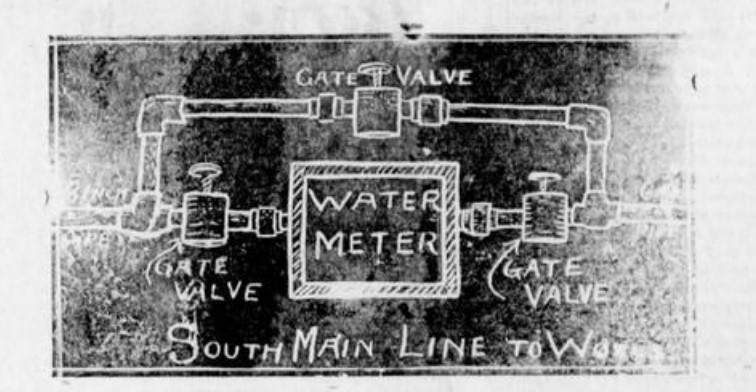
It stated that this was done “very cleverly” and the door on the box that housed this bypass and meter was built from heavy oak and locked by an extra heavy yale lock. In fact, several employees had known of this bypass for years.
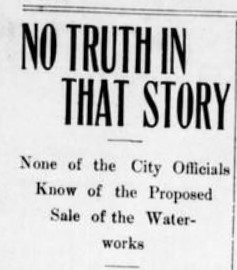
Sapulpa Evening Democrat, March 23, 1912: “No Truth in That Story. None of the city officials know of the proposed sale of the water-works. All such propositions must be submitted to a vote of the people of the city. Mayor Denton, Commissioners Lowdermilk, Rice, and Hills, all state to Democrat reporter that they had never received any word from any person in reference to a proposed sale of the waterworks. Nor could any person or corporation buy the plant at any price without a vote of the people.”
The Sapulpa Evening Democrat ran an article refuting the Light’s story on selling the water plant and the water meter bypass. The article began with, “with evil intent, not only to the city but to some of the nominees for city offices, the Evening Light has announced a pretended bargain for the sale of the city waterworks.” The Democrat pointed out that the water plant could be sold only by a vote of the people, and that the Light was well aware of this fact.
Sapulpa Evening Democrat, March 25, 1912: “That ‘Dirty Campaign’ Has Commenced.”
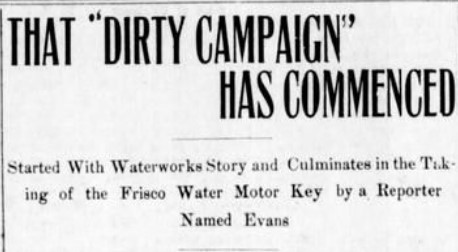
As for the bypass around the meter, the Democrat said that it was correct the bypass had been in for some time. It was first installed when Frisco obtained their water from the plant on South Hickory. This plant did not filter the water, and from time to time, when it became muddy, it would clog up the meter.
Therefore, a bypass was installed to ensure Frisco with an adequate supply. Frisco had also agreed to pay the highest price for any water used in any same previous month. It was also pointed out that this meter was only for the roundhouse and that Frisco had other meters.
The newspapers would respond back and forth for the rest of the week.
Sapulpa Evening Democrat, March 26, 1912: “Everyone Asked Denies the Waterworks Story.” The reporter of the Democrat reached out to the editor of the Light to help explain the misrepresented story of the bypass. However, the editor replied “I don’t care whether it is so or not, it’s a good campaign dope.”
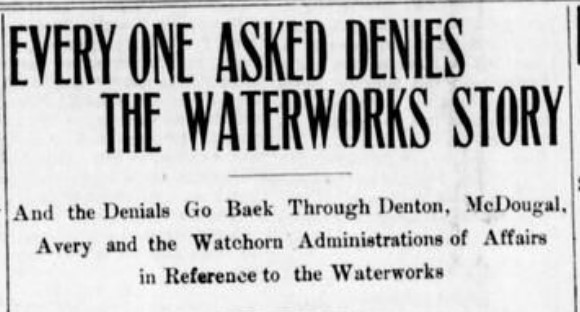
Sapulpa Evening Light, March 28, 1912: “Sapulpa Has the Only and the Original By-Pass.” The Lights continued its story on the bypass by sending telegrams to every city on the Frisco system. It asked if they, too, had a bypass installed. No one did. It published the question and each telegram responses.
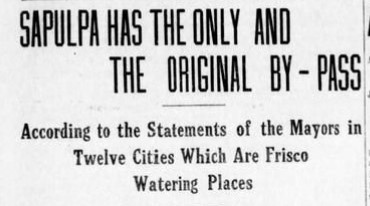
Sapulpa Evening Democrat, March 30, 1912: “Light Story that the Frisco was Robbing City Knocked into a Cocked Hat.” The Democrat printed a letter from J.A. Boyd, who was the chairman of the water committee when the meter was installed. The letter indicated that the meter was installed in 1902. It recounted the story of the clogged drain. And that the bypass was installed to allow Frisco the water in case of fires due to there was not a fire hydrant in the yards.

It seemed it finally ended the bickering. That, and another story came forward.
Both newspapers agreed that they wanted the betterment of Sapulpa. The newspapers were always pushing for a progressive Sapulpa. They would often include many stories of how Sapulpa was a great town. And those who were not for the newest, cleanest, prettiest, progressive town, both newspapers called the opposers out – they even had a nickname for the opposers; they were called “knockers.”
“Knockers” never attended meetings or belonged to a civic club, but did criticize any suggestions or programs made by others. They were the ones who spread rumors and falsehoods about the programs, or those who instigated them.
“Knockers” continually knocked down the town.
Sapulpa Evening Light, April 22, 1912: “One Suggests Corporation; Another ‘Kill the Knocker.*’”
Sapulpa Evening Light, April 26, 1912: “Boost for Cleaner City is One of the Suggestions. ‘The knockers are ruining our city.’”
Sapulpa Evening Democrat, July 15, 1912: “The steel plant may be opened for business before the leaves begin to fall. ‘Knockers’ may chirp and decry hard times, but Sapulpa moves on in the even tenor of her way.”
Sapulpa Evening Democrat, July 19, 1912: “Factories are Assured. A greater Sapulpa is no longer in doubt – boosters in evidence and ‘knockers’ gone to parts unknown.”
*This remark was not suggesting to actually murder anyone, but to kill the idea of being a knocker.



